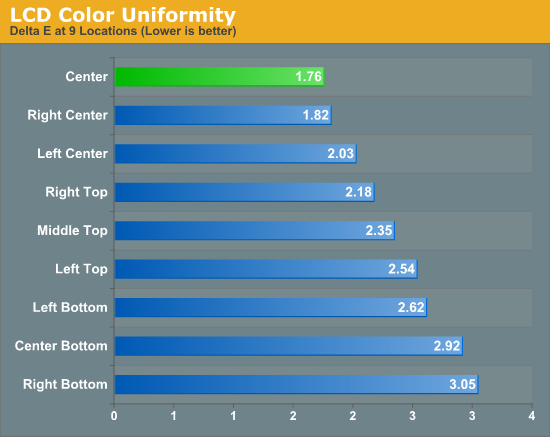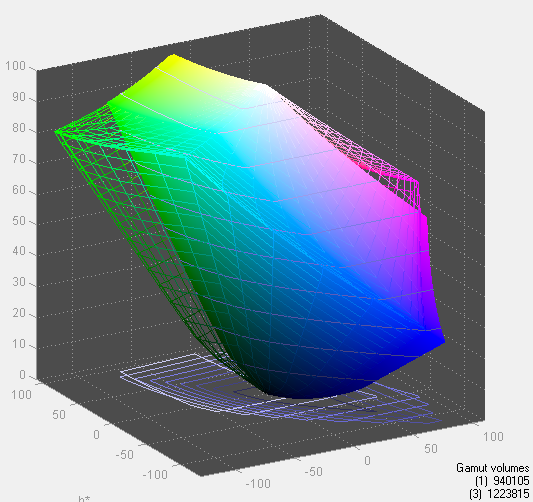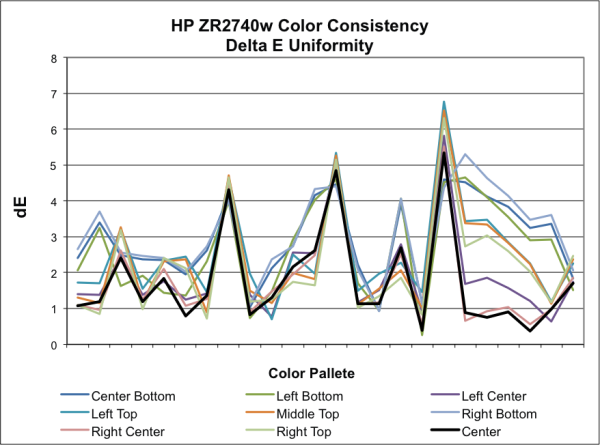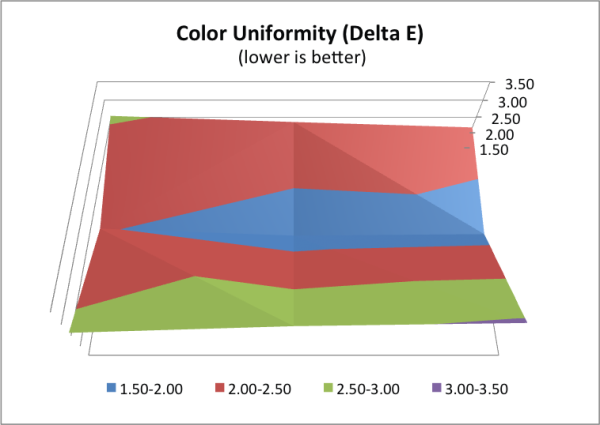HP ZR2740w - High Resolution IPS that Doesn't Break the Bank
by Chris Heinonen on March 16, 2012 1:15 AM ESTColor Uniformity and Color Gamut
The calibrated results on the ZR2740w were pretty good, but with such a large panel was the uniformity going to suffer because of it? 23” 1080p displays have a hard time with uniformity and are easier to fix, but perhaps since the HP is a higher end display more work has been put into keeping the screen uniform all around. Measuring nine points around the screen at the 200 nits calibrated setting, you can see what we found.

Only one of the nine locations had an average dE above 3, and the median value there was still below 2.75. What concerned me the most is that the uniformity on the grayscale was so bad, so when you have a solid white background, which is likely on a monitor like this with spreadsheets and other applications, you will be able to clearly see a shift in the white point as you look at it. Colors were far more consistent than white was across the display, so it seems to be a shift when the panel is fully driven, probably due to unevenness in the lighting I would assume.
While it has an 8-bit panel and can do 10-bit colors with A-FRC, the backlight system of the HP means that you aren’t going to get the full AdobeRGB colorspace on it. The HP comes out of Gamutvision with 76.82% of the AdobeRGB space, pretty much dead on to the 77.2% in the specs.













119 Comments
View All Comments
paohyean - Friday, March 16, 2012 - link
Nice monitor..I own a U2311H and I like the included USB Hub..
I just attach my webcam, Bluetooth key and wireless keyboard/mouse receiver onto it..
Reduces a lot of the cable clutter..
EnzoFX - Friday, March 16, 2012 - link
The first/early HP 30" displays did the same thing with handling the input, I don't think it scaled though. Anyways, it made for great low input lag. I remember it being one of the lowest if not the lowest for IPS displays, and probably still is, since now you have pretty advanced features and scaling stuff. I love the idea of this. I suppose I could simply rely on something else when I really need input flexibility. I only dislike the bezel HP uses =P.EnzoFX - Friday, March 16, 2012 - link
*since you have more advanced features/input handling/scaling stuff these days... I meant to say.darkswordsman17 - Friday, March 16, 2012 - link
http://hardforum.com/showthread.php?t=1675393Comes with caveats though (eBay sellers, they ship from Asia, so returns/exchanges are gonna be a pain), but seems most people are having pretty good experiences.
Zoomer - Friday, March 16, 2012 - link
Also a lower binned panel (A-) vs A++.ypsylon - Friday, March 16, 2012 - link
Running it for some time now. Bought it for equivalent of 830 USD but that is the problem with products coming from USA to Europe. Oh joys... ;pBest LCD I ever owned. The only problem I can't find with it is too high lumination - 380cd. Far too much for IPS matrix. 250 cd should be more than enough. Despite that I still love it. Lack of OSD - not an issue after calibration. Running it at lowest lumination. 99.9% imaginable task can be done at this settings. But when you crank up brightness (if you doing CAD or 3D modeling) then it hurts eyes, still it is better than 30" model from the same family which uses CCFL not LED. I was split between Dell 27" and this little beast. Went with HP for 3 main reasons: LED not CCFL, smaller power drain, pivot. For those who whining that matrix is too slow for gaming blah, blah, blah. Have you ever played with monitor equipped with matrix different than TN? 10-12ms on IPS with 1000:1 is perfect matrix. Never, not once noticed any problem with that setup. Games, movies, job. It deals perfectly with anything I can think of. Response time is important with TN. While marketing slogans on TN shout : Response time: FTL or Contrast ratio: 958000000:1. That stuff is only for idiots. Like I said. HP ZR2740w is excellent, not perfect, but still supremely fine product. I'm not a person who will whine about it being 16:9 and not 16:10. A non-issue for me, and I never was interested in 120Hz model.
JohnBooty - Friday, March 16, 2012 - link
"The only problem I can't find with it is too high lumination - 380cd. Far too much for IPS matrix. 250 cd should be more than enough."Do LED backlights get dimmer over time, like CCFL backlights?
With CCFLs, you definitely want to buy one with more illumination than you'll ever need, since the maximum brightness will fade considerably over time - the 300cd CCFL monitor you buy today might only be able to produce 200cd after a few years of heavy use.
But I'm unclear as to whether this is an issue with LED backlighting.
Tetracycloide - Friday, March 16, 2012 - link
LEDs definitely fade over time. They're supposed to last longer than CCFLs though but I'm not sure what that means in terms of illumination. Assuming they fade at the same rate relative to their lifespan it means LEDs will fade but fade more slowly but that's a pretty big assumption. Your guess is probably as good as mine but I can say for certain that LEDs do fade.Swirlser - Friday, March 16, 2012 - link
My apple 30s are 6 or 7 years old now, so those res's have been around quite a bit more than a few years.Pretty cheap looking and performing monitors, but I guess they are priced as such. So an adequate option for those not pushed on finer details.
(wish apple didn't stop making the 30s, hate to think that a decade on when I need new monitors I'll possibly be downsizing!)
Tchamber - Friday, March 16, 2012 - link
I have this unit's little brother, the ZR24, and I love it. Viewing angles are great from this line. I do like that mine has an OSD, though. I think it's funny that the OP said it's too much money for a 16:9 monitor, when it has much more resolution than 99.9% of monitors out there :) people always say 1920x1080 is too little, now 1440 is too little too...